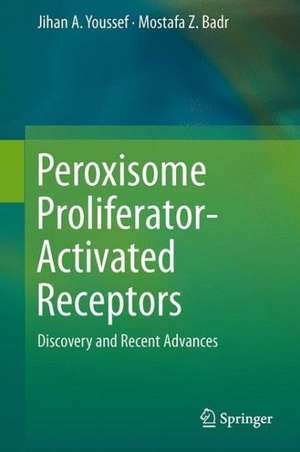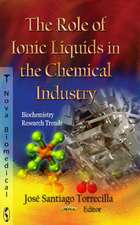Peroxisome Proliferator-Activated Receptors: Discovery and Recent Advances
Autor Jihan A. Youssef, Mostafa Z. Badren Limba Engleză Hardback – 19 apr 2013
As PPARs play critical roles as regulators of numerous physiological as well as pathophysiological pathways, Peroxisome Proliferator-Activated Receptors: Discovery and Recent Advances aims to help researchers to develop safer and more effective PPAR modulators as therapeutic agents to treat a myriad of diseases and conditions.
Toate formatele și edițiile
| Toate formatele și edițiile | Preț | Express |
|---|---|---|
| Paperback (1) | 684.04 lei 6-8 săpt. | |
| Humana Press Inc. – 22 mai 2015 | 684.04 lei 6-8 săpt. | |
| Hardback (1) | 942.63 lei 6-8 săpt. | |
| Humana Press Inc. – 19 apr 2013 | 942.63 lei 6-8 săpt. |
Preț: 942.63 lei
Preț vechi: 1149.54 lei
-18% Nou
Puncte Express: 1414
Preț estimativ în valută:
180.37€ • 188.83$ • 149.25£
180.37€ • 188.83$ • 149.25£
Carte tipărită la comandă
Livrare economică 08-22 aprilie
Preluare comenzi: 021 569.72.76
Specificații
ISBN-13: 9781627034197
ISBN-10: 1627034196
Pagini: 137
Ilustrații: IX, 137 p.
Dimensiuni: 155 x 235 x 20 mm
Greutate: 0.36 kg
Ediția:2013
Editura: Humana Press Inc.
Colecția Humana
Locul publicării:Totowa, NJ, United States
ISBN-10: 1627034196
Pagini: 137
Ilustrații: IX, 137 p.
Dimensiuni: 155 x 235 x 20 mm
Greutate: 0.36 kg
Ediția:2013
Editura: Humana Press Inc.
Colecția Humana
Locul publicării:Totowa, NJ, United States
Public țintă
Professional/practitionerCuprins
Introduction.- History of PPAR Discovery: Peroxisomes.- Peroxisomal biogenesis and diseases.- Peroxisome proliferation.- Peroxisome Proliferator-Activated Receptors: Chromosomal location and gene polymorphism.- Protein structure.- PPAR Ligands: Endogenous ligands.- Exogenous PPAR modulators.- Tissue Distribution and Versatile Functions of PPARs: Neurological functions of PPARs.- PPARs and the cardiovascular system.- PPARs in pulmonary physiology and disease.- Gastrointestinal roles of PPARs.- PPAR functions in the liver.- Roles of PPARs in the pancreas.- PPARs in the urinary tract physiology and pathophysiology.- PPARs in the reproductive system.- Bone metabolism and PPARs.- Roles of PPARs in skeletal muscle biology.- Skin PPARs.- PPARs and Drug Metabolism.- Molecular Aspects of PPAR Actions: Posttranslational control of PPARs.- Mechanism of action.- Animal Models in PPAR Research.- Safety of PPAR Agonists.- The Future of PPAR Research.
Textul de pe ultima copertă
All three peroxisome proliferator-activated receptor (PPAR) subtypes share a high degree of structural homology while exhibiting differences in function, tissue distribution, and ligand specificity. In Peroxisome Proliferator-Activated Receptors: Discovery and Recent Advances, the authors trace the history of PPAR discovery and detail the receptor structure and its posttranslational modifications. Furthermore, endogenous ligands as well as various classes of exogenous ligands, subtype-selective, dual and pan agonists as well as antagonists, are discussed. In addition, the tissue distribution and versatile functions of PPAR subtypes in major organs are described.
As PPARs play critical roles as regulators of numerous physiological as well as pathophysiological pathways, Peroxisome Proliferator-Activated Receptors: Discovery and Recent Advances aims to help researchers to develop safer and more effective PPAR modulators as therapeutic agents to treat a myriad of diseases and conditions.
As PPARs play critical roles as regulators of numerous physiological as well as pathophysiological pathways, Peroxisome Proliferator-Activated Receptors: Discovery and Recent Advances aims to help researchers to develop safer and more effective PPAR modulators as therapeutic agents to treat a myriad of diseases and conditions.
Caracteristici
Traces PPAR discovery through its history and to its modern state Paves the way for the development of safer and more effective PPAR modulators as therapeutic agents Serves as an excellent companion to Volume 952 of the Methods in Molecular Biology series






